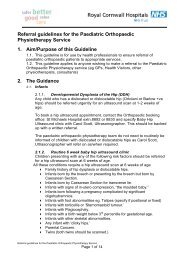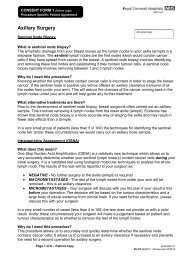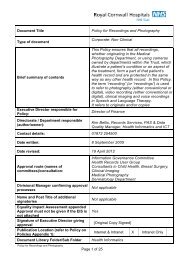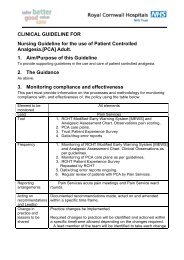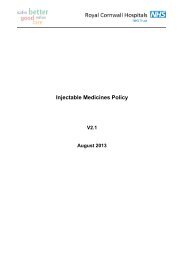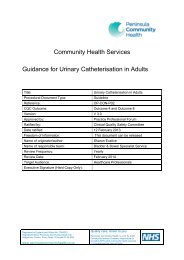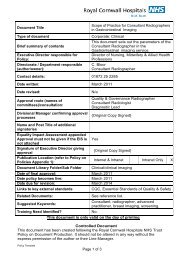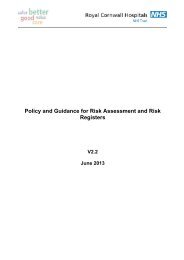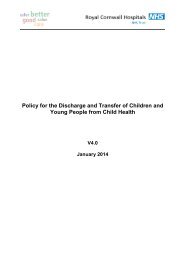Clinical Audit - the Royal Cornwall Hospitals Trust website...
Clinical Audit - the Royal Cornwall Hospitals Trust website...
Clinical Audit - the Royal Cornwall Hospitals Trust website...
Create successful ePaper yourself
Turn your PDF publications into a flip-book with our unique Google optimized e-Paper software.
Peninsula Community Health<br />
<strong>Clinical</strong> <strong>Audit</strong> Policy<br />
Title:<br />
<strong>Clinical</strong> <strong>Audit</strong> Policy<br />
Procedural Document Type:<br />
Policy<br />
Reference:<br />
CGP46<br />
Version:<br />
V1<br />
Ratified by:<br />
CIOS Community Health Services Board<br />
Date ratified: 27 th January 2011<br />
Freedom of Information:<br />
This document can be released<br />
Name of originator/author:<br />
Sally Shipley<br />
Name of responsible team:<br />
Governance<br />
Review Frequency:<br />
3 Years<br />
Review date: 27 th January 2014<br />
Target audience:<br />
All staff<br />
Exec Signature (Hard Copy Only):<br />
V1 Page 1 of 16 6-Aug-12
<strong>Clinical</strong> <strong>Audit</strong> Policy<br />
Contents<br />
1 Introduction ........................................................................................................ 3<br />
2 Definitions .......................................................................................................... 3<br />
3 Equality Impact Assessment .............................................................................. 4<br />
4 Good Corporate Citizen...................................................................................... 5<br />
5 Duties................................................................................................................. 5<br />
6 Commitment to Stakeholder Engagement, Collaboration and Partnership 7<br />
7 Process for Setting Priorities for a <strong>Clinical</strong> <strong>Audit</strong> Programme Including<br />
Participation in National and Local <strong>Audit</strong>s 7<br />
8 Process for Ensuring Appropriate Standards of Performance are <strong>Audit</strong>ed 8<br />
9 Format for All <strong>Clinical</strong> <strong>Audit</strong> Reports 8<br />
10 Process for Disseminating <strong>Audit</strong> Results / Reports 9<br />
11 Process for Making Improvements 9<br />
12 Process for Monitoring Action Plans and Carrying out Re-audits 9<br />
13 Data Protection 9<br />
14 Ethics and Consent 10<br />
15 Training 10<br />
16 Risk Management Strategy Implementation..................................................... 10<br />
16.1 Implementation ................................................................................... 10<br />
16.2 Training and Support .......................................................................... 10<br />
16.3 Dissemination ..................................................................................... 11<br />
16.4 Storing <strong>the</strong> Procedural Document....................................................... 11<br />
17 Process for Monitoring Effective Implementation ............................................. 11<br />
18 Associated Documentation............................................................................... 11<br />
19 References....................................................................................................... 11<br />
Appendix A <strong>Clinical</strong> audit proposal form 13<br />
Appendix B <strong>Clinical</strong> audit report template 15<br />
Please Note <strong>the</strong> Intention of this Document<br />
“This policy provides guidance for all staff participating in clinical audit activities. It includes<br />
<strong>the</strong> organisations procedures and expectations for registering and approving clinical audit<br />
project proposals”.<br />
V1 Page 2 of 16 6-Aug-12
<strong>Clinical</strong> <strong>Audit</strong> Policy<br />
1. Introduction<br />
The expectation for healthcare professionals to participate in regular clinical audit was first<br />
established in <strong>the</strong> 1989 Government White Paper, ‘Working for Patients’. This has been<br />
reinforced and extended by a succession of key national publications, including:<br />
The New NHS — Modern Dependable (Department of Health, 1997)<br />
A First Class Service (Department of Health, 1998)<br />
<strong>Clinical</strong> Governance — Quality in <strong>the</strong> NHS (Department of Health, 1999)<br />
Learning from Bristol: <strong>the</strong> report of <strong>the</strong> public inquiry into children’s heart surgery at<br />
Bristol <strong>Royal</strong> Infirmary 1984–1995 [<strong>the</strong> ‘Kennedy Report’] (Department of Health, 2002)<br />
Good Medical Practice (General Medical Council, 2001)<br />
National Standards, Local Action (Department of Health 2004)<br />
Good Doctors Safer Patients (Department of Health, 2006)<br />
<strong>Trust</strong> Assurance & Safety (Department of Health, 2007)<br />
<br />
The NHS Next Stage Review Final Report, High Quality Care For All [<strong>the</strong> ‘Darzi Report’],<br />
(Department of Health, 2008).<br />
Essential Standards of Quality and Safety (Care Quality Commission, 2009)<br />
Equity and Excellence, Liberating <strong>the</strong> NHS (Department of Health, 2010)<br />
Essential Standards of Quality and Safety outcome 16 states that organisations are required<br />
to regularly assess and monitor <strong>the</strong> quality of <strong>the</strong> services provided.<br />
NHS LA Risk Management Standards: standard 5, criterion 1 has been developed as a pilot<br />
for clinical audit for 2010/11.<br />
Peninsula Community Health expects all qualified health care professionals to participate in<br />
clinical audit as part of a structured programme of work including <strong>the</strong> annual record keeping<br />
audit<br />
The organisation supports <strong>the</strong> view that whilst <strong>Clinical</strong> <strong>Audit</strong> is fundamentally a quality<br />
improvement process, it also plays an important role in providing assurances about <strong>the</strong><br />
quality of services.<br />
2. Definitions<br />
2.1 <strong>Clinical</strong> audit<br />
<strong>Clinical</strong> <strong>Audit</strong> may be defined as “a quality improvement process that seeks to improve<br />
patient care and outcomes through systematic review of care against explicit criteria and<br />
<strong>the</strong> implementation of change. Aspects of <strong>the</strong> structure, processes, and outcomes of<br />
care are selected and systematically evaluated against explicit criteria. Where indicated,<br />
changes are implemented at an individual, team or service level and fur<strong>the</strong>r monitoring is<br />
used to confirm improvement in healthcare delivery”.<br />
V1 Page 3 of 16 6-Aug-12
<strong>Clinical</strong> <strong>Audit</strong> Policy<br />
2.2 Difference between clinical audit and research<br />
<strong>Clinical</strong> audit measures existing practice against evidence-based clinical standards.<br />
Research is about obtaining new knowledge and finding out what treatments are <strong>the</strong><br />
most effective<br />
<strong>Clinical</strong> audit is about quality and finding out if best practice is being practised. Research<br />
tells us what we should be doing. <strong>Clinical</strong> audit tells us whe<strong>the</strong>r we are doing what we<br />
should be doing and how well we are doing it.<br />
2.3 National <strong>Clinical</strong> <strong>Audit</strong> Advisory Group (NCAAG)<br />
The National <strong>Clinical</strong> <strong>Audit</strong> Advisory Group (NCAAG) has been established to drive <strong>the</strong><br />
reinvigoration programme and provide a national focus for discussion and advice on<br />
matters relating to clinical audit. The NCAAG also provides strategic advice and<br />
guidance to <strong>the</strong> Department of Health’s National <strong>Clinical</strong> <strong>Audit</strong> & Patient Outcomes<br />
Programme (NCAPOP), and in particular on proposals for new national clinical audits<br />
and for discontinuing existing ones<br />
2.4 Healthcare Quality Improvement Partnership (HQIP)<br />
The Healthcare Quality Improvement Partnership (HQIP) was established in April 2008<br />
to promote quality in healthcare, and in particular to increase <strong>the</strong> impact that clinical audit<br />
has on healthcare quality in England and Wales. It is led by a consortium of <strong>the</strong><br />
Academy of Medical <strong>Royal</strong> Colleges, <strong>the</strong> <strong>Royal</strong> College of Nursing and National Voices<br />
(formerly <strong>the</strong> Long-term Conditions Alliance).<br />
HQIP is contracted by <strong>the</strong> Department of Health to deliver a programme of activity to<br />
reinvigorate clinical audit<br />
HQIP hosts <strong>the</strong> contract to manage and develop <strong>the</strong> National <strong>Clinical</strong> <strong>Audit</strong> and Patient<br />
Outcome Programme (NCAPOP)<br />
2.5 National <strong>Clinical</strong> <strong>Audit</strong> and Patient Outcome Programme (NCAPOP)<br />
National clinical audit is designed to improve patient outcomes across a wide range of<br />
medical, surgical and mental health conditions. Its purpose is to engage all healthcare<br />
professionals across England and Wales in systematic evaluation of <strong>the</strong>ir clinical practice<br />
against standards and to support and encourage improvement and deliver better<br />
outcomes in <strong>the</strong> quality of treatment and care.<br />
The programme comprises more than 25 clinical audits that cover care provided to<br />
people with a wide range of medical, surgical and mental health conditions and will be<br />
extended to o<strong>the</strong>r areas of healthcare that are considered a priority by <strong>the</strong> National<br />
<strong>Clinical</strong> <strong>Audit</strong> Advisory Group (NCAAG) and <strong>the</strong> Department of Health.<br />
3. Equality Impact Assessment<br />
Peninsula Community Health aims to design and implement services, policies and measures<br />
that meet <strong>the</strong> diverse needs of our service, population and workforce, ensuring that none are<br />
placed at a disadvantage over o<strong>the</strong>rs.<br />
V1 Page 4 of 16 6-Aug-12
<strong>Clinical</strong> <strong>Audit</strong> Policy<br />
As part of its development, this strategy and its impact on equality have been reviewed in<br />
consultation with trade union and o<strong>the</strong>r employee representatives in line with <strong>the</strong> Equality<br />
and Diversity Policy. The purpose of <strong>the</strong> assessment is to minimise and if possible remove<br />
any disproportionate impact on employees on <strong>the</strong> grounds of race sex, disability, age, sexual<br />
orientation or religious belief. No detriment was identified.<br />
The Equality Impact Assessment Tool has been used to help consider <strong>the</strong> needs and assess<br />
<strong>the</strong> impact of this policy and has been completed alongside this document.<br />
4. Good Corporate Citizen<br />
As part of its development, this policy was reviewed in line with <strong>the</strong> Good Corporate Citizen<br />
Action Plan. The implementation of this strategy promotes good governance.<br />
5. Duties<br />
5.1 Chief Executive<br />
The Chief Executive is responsible for <strong>the</strong> statutory duty of quality and takes overall<br />
responsibility for this policy.<br />
5.2 Peninsula Community Health Services Board<br />
The <strong>Cornwall</strong> & Isles of Scilly Community Health Services Board has delegated<br />
overall responsibility for clinical audit to <strong>the</strong> Integrated Governance Committee. The<br />
board will act on <strong>the</strong> recommendations contained in ‘<strong>Clinical</strong> audit: A simple guide for<br />
NHS boards (2009) including <strong>the</strong> Board Engagement Matrix (2010)’ available at<br />
www.hqip.org.uk.<br />
5.3 <strong>Clinical</strong> Quality and Safety Committee<br />
Responsibility for clinical audit has been delegated by <strong>the</strong> board to <strong>the</strong> Integrated<br />
Governance Committee.<br />
The committee is responsible for:<br />
<br />
<br />
<br />
Agreeing <strong>the</strong> organisations priorities for clinical audit<br />
Approving <strong>the</strong> annual clinical audit plan<br />
Ensuring participation in all relevant audits contained in <strong>the</strong> National<br />
<strong>Clinical</strong> <strong>Audit</strong> and Patient Outcome Programme<br />
Ensuring all high contracted clinical audits (CQUINs, quality clinical<br />
audit plan) are undertaken and completed.<br />
Receiving summaries of completed clinical audit projects including<br />
taking appropriate action where necessary<br />
5.4 Director of Nursing and Professional Practice<br />
The Director of Nursing and Professional Practice provides board leadership<br />
for clinical audit<br />
5.5 Senior Managers / Service leads<br />
V1 Page 5 of 16 6-Aug-12
<strong>Clinical</strong> <strong>Audit</strong> Policy<br />
Senior managers and service leads are responsible for:<br />
<br />
Maintaining <strong>the</strong> services local clinical audit programme<br />
Ensuring <strong>the</strong> organisations priorities for clinical audit are met in <strong>the</strong><br />
first instance.<br />
<br />
<br />
<br />
<br />
Approving clinical audit proposals from staff within <strong>the</strong>ir service<br />
Forwarding all clinical audit proposal forms to <strong>the</strong> clinical effectiveness<br />
manager<br />
Ensuring all local clinical audit activity is completed in accordance with<br />
this policy<br />
Ensuring all clinical audit reports are sent to <strong>the</strong> clinical effectiveness<br />
manager<br />
5.6 <strong>Clinical</strong> Effectiveness Manager<br />
The <strong>Clinical</strong> Effectiveness Manager is responsible for:<br />
<br />
Developing, implementing, supporting and monitoring progress of <strong>the</strong><br />
annual clinical audit plan.<br />
Ensuring clinical audit (CQUINs, quality clinical audit plan) targets<br />
contained in <strong>the</strong> Community Health Services contract are included in<br />
<strong>the</strong> clinical audit plan and progress reported via <strong>the</strong> contract<br />
monitoring process<br />
<br />
<br />
<br />
Developing and reviewing Peninsula Community Health clinical audit<br />
policy.<br />
Providing advice and support in all aspect of clinical audit for all staff<br />
employed by Peninsula Community Health s<br />
Providing training in clinical audit including developing suitable<br />
guidance / leaflets and tools taking into account guidance developed<br />
by HQIP<br />
Ensuring PCH are aware of national clinical audit arrangements /<br />
initiatives and relevant clinical audits.<br />
<br />
<br />
Acting as <strong>the</strong> organisations contact point for all national clinical audits<br />
Maintaining systems for co-ordinating all clinical audit activity across<br />
<strong>the</strong> organisation.<br />
5.7 All clinical staff<br />
All staff involved in <strong>the</strong> provision of care, treatment and support for patients<br />
should participate in clinical audit.<br />
All clinical staff undertaking clinical audit must:<br />
<br />
Ensure all clinical audit activity is approved by <strong>the</strong>ir relevant service<br />
lead and registered with <strong>the</strong> <strong>Clinical</strong> Effectiveness Manager.<br />
V1 Page 6 of 16 6-Aug-12
<strong>Clinical</strong> <strong>Audit</strong> Policy<br />
<br />
Undertake clinical audit in accordance with this policy and guidance<br />
obtained from <strong>the</strong> <strong>Clinical</strong> Effectiveness Manager<br />
6. Commitment to Stakeholder Engagement, Collaboration and<br />
Partnership<br />
6.1 Involving Patients and <strong>the</strong> Public<br />
Patients and <strong>the</strong> public are usually involved in clinical audit / quality<br />
improvement initiatives via patient surveys and o<strong>the</strong>r patient experience<br />
methods. Where a patient survey is undertaken to determine whe<strong>the</strong>r clinical<br />
standards are being met, <strong>the</strong> project should be treated as any o<strong>the</strong>r clinical<br />
audit project. If <strong>the</strong> patient survey asks questions about patient satisfaction<br />
and experience <strong>the</strong> project should be registered with <strong>the</strong> <strong>Clinical</strong> Quality and<br />
Patient Experience Manager<br />
6.2 Multi-disciplinary and Multi-professional <strong>Audit</strong>, and Partnership<br />
Working with o<strong>the</strong>r Organisations<br />
The organisation supports collaboration on multi-professional clinical audits of<br />
interest to o<strong>the</strong>r parts of <strong>the</strong> local health economy, both within and outside of<br />
<strong>the</strong> NHS e.g. primary/secondary care, local authorities, social services etc<br />
7. Process for Setting Priorities for a <strong>Clinical</strong> <strong>Audit</strong> Programme<br />
Including Participation in National and Local <strong>Audit</strong>s<br />
Effective <strong>Clinical</strong> <strong>Audit</strong> is not a simple task and <strong>the</strong> pressure of incorporating complex<br />
requirements into an ever increasing workload presents yet ano<strong>the</strong>r demand on clinical time.<br />
It is <strong>the</strong>refore important for Peninsula Community Health to demonstrate a systematic<br />
approach to audit topic selection, taking into account any organisational priorities and new<br />
government initiatives toge<strong>the</strong>r with any local needs. This will ensure time is spent efficiently<br />
by concentrating on well-structured audit projects that produce effective results and<br />
highlights areas of practice requiring change. The aim is to increase audit activity across<br />
Peninsula Community Health and to reduce <strong>the</strong> number of poorly conducted audits that are<br />
often unsupported, carried out under pressure, and on occasions never completed.<br />
The <strong>Clinical</strong> <strong>Audit</strong> Plan will be determined by <strong>the</strong> <strong>Clinical</strong> Quality and Safety Committee<br />
based upon <strong>the</strong> four categories below:<br />
1: External ‘must do’ audits: Failure to participate or deliver on <strong>the</strong>se externally driven<br />
audits may carry a penalty for PCH (ei<strong>the</strong>r financial or in <strong>the</strong> form of a failed target or<br />
non-compliance). These are externally monitored and assessed by <strong>the</strong> CQC and in<br />
some areas by <strong>the</strong> local PCT commissioner.<br />
National <strong>Clinical</strong> <strong>Audit</strong> & Patient Outcome Programme (NCAPOP)<br />
<strong>Audit</strong>s demonstrating compliance with regulation requirements e.g. NICE<br />
guidance, NSFs, NPSA alerts<br />
CQUINS and o<strong>the</strong>r commissioner priorities<br />
<br />
<br />
DH statutory requirements, e.g infection control monitoring<br />
External accreditation schemes, e.g., NHS Litigation Authority (NHSLA),<br />
Information Governance Toolkit (IGT)<br />
2: Internal ‘must do’ audits: Priorities reflective of organisational objectives for clinical<br />
audit as outlined in <strong>the</strong> local clinical audit strategy or strategic objectives<br />
<strong>Clinical</strong> risk issues<br />
V1 Page 7 of 16 6-Aug-12
<strong>Clinical</strong> <strong>Audit</strong> Policy<br />
<br />
<br />
<br />
<br />
<br />
<br />
Serious untoward incidents/adverse incidents<br />
Organisational clinical priorities<br />
Priorities identified via Patient and Public Involvement initiatives<br />
Complaints<br />
Access<br />
Patient Safety First Campaign<br />
3: Business Unit / Service priorities<br />
<br />
<br />
<br />
Local clinical interest audit agreed by business units/services as a priority<br />
National audits not part of NCAPOP, e.g. some <strong>Royal</strong> College initiated projects<br />
that lie outside of NCAPOP<br />
Locally adopted clinical standards benchmarking e.g., Essence of Care<br />
4. Clinician interest<br />
8. Process for Ensuring Appropriate Standards of Performance<br />
are <strong>Audit</strong>ed<br />
All clinical audit activity must be registered with <strong>the</strong> <strong>Clinical</strong> Effectiveness Manager giving<br />
details of <strong>the</strong> guideline / policy / protocol to be audited. This will ensure that projects that do<br />
not measure compliance e.g. patient satisfaction surveys, research, and baseline<br />
assessments are managed by <strong>the</strong> appropriate departments<br />
Guidance developed by <strong>the</strong> <strong>Clinical</strong> Effectiveness Manager will describe how to develop<br />
measurable audit criteria<br />
The <strong>Clinical</strong> Effectiveness Manager is part of <strong>the</strong> consultation process for all procedural<br />
documents to ensure appropriate monitoring arrangements.<br />
9. Format for All <strong>Clinical</strong> <strong>Audit</strong> Reports<br />
All clinical audit reports will follow an agreed format. A template can be found in Appendix B<br />
<br />
<br />
<br />
<br />
<br />
<br />
<br />
<br />
Introduction / Background<br />
Policy / guideline audited<br />
Methodology<br />
Summary / Conclusions<br />
Recommendations<br />
Action plan<br />
Results<br />
Appendices<br />
10. Process for Disseminating <strong>Audit</strong> Results/Reports<br />
All clinical audit reports should be discussed at <strong>the</strong> relevant service team meetings and<br />
circulated to all staff affected by <strong>the</strong> results.<br />
V1 Page 8 of 16 6-Aug-12
<strong>Clinical</strong> <strong>Audit</strong> Policy<br />
A summary will be taken by <strong>the</strong> <strong>Clinical</strong> Effectiveness Manager to <strong>the</strong> <strong>Clinical</strong> Quality and<br />
Safety Committee for information / action. The committee will take appropriate action where<br />
indicated. This could include adding to <strong>the</strong> risk register, requesting a formal response,<br />
attendance at <strong>the</strong> next meeting.<br />
11. Process for Making Improvements<br />
All clinical audit reports must include recommendations and actions before <strong>the</strong> audit can be<br />
classed as ‘final’<br />
Action plans should be specific, measurable and achievable/realistic. They should have clear<br />
implementation timescales with identified leads for action. Action plans should also have<br />
been approved by <strong>the</strong> relevant head of service or department.<br />
A summary of each audit including recommendations and actions will be taken to <strong>the</strong> <strong>Clinical</strong><br />
Quality and Safety Committee by <strong>the</strong> <strong>Clinical</strong> Effectiveness Manager<br />
Final reports will be added to <strong>the</strong> Peninsula Community Health intranet site by <strong>the</strong> <strong>Clinical</strong><br />
Effectiveness Manager.<br />
12. Process for Monitoring Actions Plans and Carrying out Reaudits<br />
Re-audit is important to determine whe<strong>the</strong>r agreed actions have been implemented<br />
according to <strong>the</strong> action plan.<br />
The monitoring of action plans will be undertaken by <strong>the</strong> <strong>Clinical</strong> Quality and Safety<br />
Committee.<br />
The <strong>Clinical</strong> Effectiveness Manager will follow up actions resulting from clinical audit reports<br />
on a 6 monthly basis. Concerns will be taken to <strong>the</strong> <strong>Clinical</strong> Quality and Safety Committee<br />
for action.<br />
Re-audits will be undertaken as required and where indicated by <strong>the</strong> initial results included in<br />
<strong>the</strong> action plan. Advice should be sought from <strong>the</strong> <strong>Clinical</strong> Effectiveness Manager<br />
13. Data Protection<br />
All clinical audit activity must take account of <strong>the</strong> Data Protection Act 1998 and <strong>the</strong> ‘Caldicott<br />
principles’ (Caldicott Committee, 1997). This means, for example, that data should be:<br />
<br />
<br />
<br />
<br />
<br />
adequate, relevant and not excessive<br />
accurate<br />
processed for limited purposes<br />
held securely<br />
not kept for longer than is necessary.<br />
All clinical audit data must be anonymised in accordance with <strong>the</strong> Peninsula Community<br />
Heath Pseudoanonymisation Policy (2010) once <strong>the</strong> patient sample has been identified. Any<br />
records containing patient identifiable data must be destroyed as soon as <strong>the</strong> audit has been<br />
completed.<br />
V1 Page 9 of 16 6-Aug-12
<strong>Clinical</strong> <strong>Audit</strong> Policy<br />
<strong>Clinical</strong> audit records should be stored and retained for a period of 5 years in accordance<br />
with <strong>the</strong> Peninsula Community Health Records Management Policy and Procedure.<br />
The NHS Confidentiality Code of Practice (DH, 2003, p.21) states that “patients must be<br />
made aware that <strong>the</strong> information <strong>the</strong>y give may be recorded, may be shared in order to<br />
provide <strong>the</strong>m with care, and may be used to support local clinical audit”. Peninsula<br />
Community Health makes provision for this in its leaflet entitled ‘Protecting Your Data, How<br />
we use your health records’. This allows patient identifiable data to be collected for clinical<br />
audit purposes as agreed in section 60 of <strong>the</strong> Health and Social Care Act 2001<br />
14. Ethics and Consent<br />
By definition, clinical audit projects should not require formal approval from a Research<br />
Ethics Committee. However one of <strong>the</strong> principles underpinning clinical audit is that <strong>the</strong><br />
process should do good and not do harm. <strong>Clinical</strong> audit must always be conducted within an<br />
ethical framework that considers whe<strong>the</strong>r<br />
<br />
<br />
<br />
<br />
<strong>the</strong>re is a benefit to existing or future patients or o<strong>the</strong>rs that outweighs<br />
potential burdens or risks;<br />
each patient’s right to self-determination is respected;<br />
each patient’s privacy and confidentiality are preserved;<br />
<strong>the</strong> activity is fairly distributed across patient groups.<br />
15. Training<br />
All clinical staff should be involved in clinical audit activities in order to develop <strong>the</strong>ir own<br />
capability around audit and effectiveness and to proceed with making clinical audit part of<br />
routine practice.<br />
The <strong>Clinical</strong> Effectiveness Manager will provide training in clinical audit to enable clinical<br />
staff to undertake clinical audits with minimal support.<br />
Training will be provided on an ad-hoc basis by <strong>the</strong> <strong>Clinical</strong> Effectiveness Manager when<br />
requested.<br />
The <strong>Clinical</strong> Effectiveness Manager will develop and make available clinical audit guidance<br />
materials.<br />
16. Risk Management Strategy Implementation<br />
16.1 Implementation<br />
The <strong>Clinical</strong> Effectiveness Manager will be responsible for <strong>the</strong> implementation of<br />
this policy.<br />
The policy will be circulated to all members of <strong>the</strong> <strong>Clinical</strong> Quality and Safety<br />
Committee, Professional Practice Forum and all service/ business leads, within 2<br />
months of <strong>the</strong> date of ratification<br />
16.2 Training and Support<br />
Training and support for <strong>the</strong> implantation of this policy and clinical audit in general<br />
will be provided by <strong>the</strong> <strong>Clinical</strong> Effectiveness Manager<br />
V1 Page 10 of 16 6-Aug-12
<strong>Clinical</strong> <strong>Audit</strong> Policy<br />
16.3 Dissemination<br />
Once ratified this policy will be loaded to <strong>the</strong> intranet (read only)<br />
Staff will be made aware of its existence through <strong>the</strong> daily briefing email and <strong>the</strong><br />
fortnightly Team Briefing.<br />
Confirmation of receipt is not required for this procedural document.<br />
16.4 Storing <strong>the</strong> Procedural Document<br />
The signed procedural document will be stored (hard copy) centrally, as will <strong>the</strong><br />
digital (soft copy) version.<br />
17. Process for Monitoring Effective Implementation<br />
The effective implementation of this policy will be monitored by <strong>the</strong> <strong>Clinical</strong> Quality and<br />
Safety Committee.<br />
An annual clinical audit report will be produced by <strong>the</strong> <strong>Clinical</strong> Effectiveness Manager<br />
outlining compliance with <strong>the</strong> annual clinical audit programme and <strong>the</strong> policy.<br />
The <strong>Clinical</strong> Effectiveness Manager will monitor <strong>the</strong> use of appropriate standards at <strong>the</strong> time<br />
of initial project registration and again once <strong>the</strong> final report has been produced.<br />
The clinical audit programme includes details of which committee and <strong>the</strong> date <strong>the</strong> audit<br />
results were presented. The programme is updated on a monthly basis by <strong>the</strong> <strong>Clinical</strong><br />
Effectiveness Manager and taken to <strong>the</strong> <strong>Clinical</strong> Quality and Safety Committee for<br />
monitoring. Where it is identified that audits haven’t been presented, <strong>the</strong> service lead will be<br />
contacted to expedite matters.<br />
18. Associated Documentation<br />
This document references <strong>the</strong> following supporting documents which should be referred to in<br />
conjunction with <strong>the</strong> document being developed.<br />
Records Management Policy and Procedure 2010<br />
Pseudonymisation Policy 2010<br />
19. References<br />
Health and Social Care Act 2001. London: The stationary Office. Available at<br />
www.opsi.gov.uk<br />
Healthcare Quality Improvement Partnership: clinical audit guidance and support, Available<br />
at http://www.hqip.org.uk/guidance-support/<br />
National Institute for <strong>Clinical</strong> Health and Excellence. Principles for Best Practice in <strong>Clinical</strong><br />
<strong>Audit</strong>. Abingdon: Radcliffe Medical Press; 2002, p. 1.<br />
V1 Page 11 of 16 6-Aug-12
<strong>Clinical</strong> <strong>Audit</strong> Policy<br />
Appendix A<br />
File ref: __________<br />
(<strong>Audit</strong> use only)<br />
<strong>Clinical</strong> <strong>Audit</strong> Proposal Form<br />
All clinical audit projects should be registered with <strong>the</strong> <strong>Clinical</strong> <strong>Audit</strong> Department for inclusion<br />
in <strong>the</strong> annual <strong>Clinical</strong> <strong>Audit</strong> Plan. This form should be completed for all clinical audit projects<br />
you wish to undertake. Please return completed forms to:<br />
<strong>Clinical</strong> Effectiveness Manager, Sedgemoor Centre, St Austell, PL25 5DS<br />
Title of Project:<br />
Your Details: (<strong>Audit</strong> Project Lead)<br />
Name:<br />
Address:<br />
Position / Job Title:<br />
Contact Tel No:<br />
E-mail Address:<br />
Priority: See guidance on page 2.<br />
Please delete as appropriate<br />
Rationale: e.g. Contract requirement, NICE, SUI,<br />
Service Priority<br />
1 2 3 4<br />
Guidelines, Policies, Protocols to be audited:<br />
Why are you undertaking this audit and what are your objectives?<br />
Start date:<br />
Completion date:<br />
For fur<strong>the</strong>r information and assistance please contact Tim Bowler<br />
on 01726 627643<br />
Peninsula Community Health <strong>Clinical</strong> <strong>Audit</strong> Plan will be determined by <strong>the</strong> <strong>Clinical</strong><br />
Quality and Safety Committee based upon <strong>the</strong> four categories below:<br />
V1 Page 12 of 16 6-Aug-12
<strong>Clinical</strong> <strong>Audit</strong> Policy<br />
1: External ‘must do’ audits: Failure to participate or deliver on <strong>the</strong>se externally driven<br />
audits may carry a penalty for PCH (ei<strong>the</strong>r financial or in <strong>the</strong> form of a failed target or noncompliance).<br />
These are externally monitored and assessed by <strong>the</strong> CQC and in some areas<br />
by <strong>the</strong> local PCT commissioner.<br />
National <strong>Clinical</strong> <strong>Audit</strong> & Patient Outcome Programme (NCAPOP)<br />
<strong>Audit</strong>s demonstrating compliance with regulation requirements e.g. NICE<br />
guidance, NSFs, NPSA alerts<br />
CQUINS and o<strong>the</strong>r commissioner priorities<br />
<br />
<br />
DH statutory requirements, e.g infection control monitoring<br />
External accreditation schemes, e.g., NHS Litigation Authority (NHSLA),<br />
Information Governance Toolkit (IGT)<br />
2: Internal ‘must do’ audits: Priorities reflective of organisational objectives for clinical audit<br />
as outlined in <strong>the</strong> local clinical audit strategy or strategic objectives<br />
<strong>Clinical</strong> risk issues<br />
Serious untoward incidents/adverse incidents (SUIs)<br />
Organisational clinical priorities<br />
Priorities identified via Patient and Public Involvement initiatives<br />
Complaints<br />
Access<br />
Patient Safety First Campaign<br />
3: Business Unit / Service priorities<br />
Local clinical interest audit agreed by business units/services as a priority<br />
National audits not part of NCAPOP, e.g. some <strong>Royal</strong> College initiated projects<br />
that lie outside of NCAPOP<br />
Locally adopted clinical standards benchmarking e.g., Essence of Care<br />
4. Clinician interest<br />
V1 Page 13 of 16 6-Aug-12
<strong>Clinical</strong> <strong>Audit</strong> Policy<br />
Appendix B<br />
Report Title<br />
Author<br />
Department<br />
Date<br />
V1 Page 14 of 16 6-Aug-12
<strong>Clinical</strong> <strong>Audit</strong> Policy<br />
<strong>Audit</strong> Title<br />
Date Range<br />
CQC Essential standards of quality and safety<br />
This report supports<br />
Domain:<br />
Outcome:<br />
Background/Introduction<br />
This should be a paragraph outlining <strong>the</strong> background information and expected benefits, ie.<br />
what <strong>the</strong> process is that you are auditing (remember, this report will be read by people<br />
outside your service). What was <strong>the</strong> problem? What were you hoping to achieve? If you<br />
undertook a literature search, say what you found giving a short description of good practice.<br />
Aims/Objectives<br />
State explicitly <strong>the</strong> specific objectives of <strong>the</strong> project (why did you do <strong>the</strong> project)?<br />
Guidelines, Protocols etc.<br />
An audit report should always be measuring against standards, guidelines or benchmarks of<br />
some sort; you need to state what <strong>the</strong>se are and where <strong>the</strong>y come from (references/<br />
bibliography). If <strong>the</strong> intention is to set standards at <strong>the</strong> end of <strong>the</strong> project, say so and state<br />
which aspects of care those standards pertain to.<br />
Methodology<br />
A short sequential list of steps that you took to carry out <strong>the</strong> audit (written in paragraph form)<br />
including any assumptions or limitations on methods. You should state your chosen<br />
population for this study (e.g. “patients referred to <strong>the</strong> one-stop breast clinic for suspected<br />
cancer”), go on to say how <strong>the</strong> sample was selected ie. “a sample of all patients seen at <strong>the</strong><br />
clinic during 1999”, in which case you would need to state <strong>the</strong> size of your sample and how it<br />
has been calculated or agreed upon. Say how you collected your data, e.g. “Data was<br />
collected from patients’ case notes using an audit tool (see Appendix)”. The method of data<br />
analysis may be mentioned briefly.<br />
Summary / Conclusions<br />
These should be written in line with <strong>the</strong> results making sure <strong>the</strong> conclusions relate to <strong>the</strong><br />
aims and objectives of <strong>the</strong> audit.<br />
Recommendations<br />
Ensure you give specific recommendations, improvements in methods and specifications for<br />
design.<br />
V1 Page 15 of 16 6-Aug-12
<strong>Clinical</strong> <strong>Audit</strong> Policy<br />
Action Plan<br />
After <strong>the</strong> report has been written <strong>the</strong> project lead should write an action plan saying who will<br />
be responsible for carrying out changes and a time-scale in which <strong>the</strong>y will do it. What has to<br />
change, who has to change or is affected by <strong>the</strong> change and who is responsible for<br />
implementing that change. When will <strong>the</strong> change take place and how will <strong>the</strong> change be<br />
monitored.<br />
1<br />
Action Date Lead<br />
2<br />
3<br />
4<br />
5<br />
6<br />
7<br />
8<br />
9<br />
References<br />
List any references that you have quoted from and include titles, names of authors/editors<br />
and year of publication and any o<strong>the</strong>r details to help o<strong>the</strong>rs find source of information if<br />
necessary<br />
Results<br />
When analysing your data you need to state what your compliance rate is with <strong>the</strong> standard<br />
you are measuring against e.g 95% of records were legible<br />
Appendices<br />
V1 Page 16 of 16 6-Aug-12
Equality Impact Assessment Tool – <strong>Clinical</strong> <strong>Audit</strong> Policy<br />
To be completed and attached to any procedural document when submitted to <strong>the</strong><br />
appropriate committee for consideration and approval.<br />
Yes √<br />
No X<br />
Comments<br />
1. Does <strong>the</strong> document/guidance affect one<br />
group less or more favourably than ano<strong>the</strong>r<br />
on <strong>the</strong> basis of:<br />
Race X<br />
Ethnic origins (including gypsies and<br />
travellers)<br />
X<br />
Nationality X<br />
Gender X<br />
Culture X<br />
Religion or belief X<br />
<br />
Sexual orientation including lesbian, gay,<br />
transgender and bisexual people<br />
X<br />
Age X<br />
Disability - learning disabilities, physical<br />
disability, sensory impairment and mental<br />
health problems<br />
2. Is <strong>the</strong>re any evidence that some groups are<br />
affected differently?<br />
3. If you have identified potential<br />
discrimination, are <strong>the</strong>re any exceptions<br />
valid, legal and/or justifiable?<br />
4. Is <strong>the</strong> impact of <strong>the</strong> document/guidance<br />
likely to be negative?<br />
X<br />
X<br />
N/A<br />
X<br />
5. If so, can <strong>the</strong> impact be avoided? N/A<br />
6. What alternative is <strong>the</strong>re to achieving <strong>the</strong><br />
document/guidance without <strong>the</strong> impact?<br />
7. Can we reduce <strong>the</strong> impact by taking<br />
different action?<br />
N/A<br />
N/A<br />
If you have identified a potential discriminatory impact of this procedural document, please<br />
refer it to <strong>the</strong> Equality and Diversity lead, toge<strong>the</strong>r with any suggestions as to <strong>the</strong> action<br />
required to avoid/reduce this impact.<br />
For advice in respect of answering <strong>the</strong> above questions, please contact <strong>the</strong> Equality and<br />
Diversity lead.<br />
V1-0 Page 1 of 1 6-Aug-12




